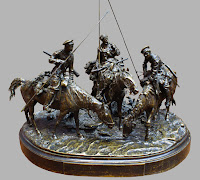Spring has come - thanks God, we need lots of sun - vitamin D and little bit of smile.
today I came across the art of Евге́ний Алекса́ндрович Лансере́ [Yevgeniy Alexandrovich Lansere (or Lanceray)].
Russian sculptor of the Imperial era, with a very interesting lineage, since his own grandfather was a soldier in the Napoleonic army before becoming a Russian subject (sort of like one famous French actor couple years ago). He was then from a French Russian family and was born near St. Petersburg, then the capital of Russia. He studied there, first he had finished the St. Petersburg 2nd Highschool and then he studied and finished the law faculty at the university there.
Then comes the amazing - perhaps a sign of time eg our Polish painter Juliusz Kossak also finished law faculty before turning to professional art, our young lawyer became a full-time artist.
He never received any formal art education, but was self-taught, however, generously using advice from various artists residing at the imperial capital. we should remember that the imperial city was full of international and national artists and teachers and thinkers, was full of amazing art collections and thus artworks abounded. Yevgeniy went several times to Paris, France. His aim was to study bronze casting, while art studying at the French capital must have come naturally and with ease.
He had loved horses since childhood and working in clay and bronze, with pencil and paints he thus become one of the greatest sculptors of horses ... and riders.
What he did differently was that he studied and observed his subjects form life, observation must have been the key to his understating of horse form, anatomy, movement and ultimately beauty.
He did plenty of historical pieces - eg Kievan Rus' prince Sviatoslav, , and contemporary ones too - Ukrainian chumaks . We should remember that the Russian Empire was growing fast during his life always expanding east and south-east )of course but for sale of Alaska to the Americans in 1867), hence many nations of Eurasian entered Russian service, by force or voluntarily. Lansere observed Bashkirs, Caucasian mountaineers, imperial Cossaks, Kirgiz nomads and many others, and in his style of taking a closer look at his subjects, he travelled into the newly conquered lands in Central Asia and in Caucassus.
He also went to Africa, visiting the Maghreb where war horse had been bread since Antiquity and Lansere had a chance to observe the famous horse-riding peoples in Algeria etc.
Yevgeniy got involved in bronze casting, and cooperated with many Russian bronze manufacturers, like Chopin Foundries etc, selling rights and/or giving permissions to multiple casting of his pieces. Thus in not too long time his castings became very popular and widespread with the Russian empire. Perhaps this is also why many of his works survived the destruction art objects caused by the Revolution, Civil War and later cultural purges and the visit of the Western Soviet Empire by the good people from Germany, nazi Germany to be precise - 1941-44. Nowadays many museums in Russian and the former Soviet republics have amongst their collections Lansere's works.
Outside Russia, Ukraine, Belarus etc Lansere's art can be seen in France - eg monument in a French city of Menton.
well, enough of my short 'write up' on this great artist's work. I have seen a book or two on his works - here or here.
Some pieces from the Wiki Commons collection - many can be seen here.
enjoy








3 comments:
http://stonecarving.ru/zastava-strelec-i-boyarskiy-syn.html
Lansere had a famous artist son https://en.wikipedia.org/wiki/Eugene_Lanceray
and artist daughter https://en.wikipedia.org/wiki/Zinaida_Serebriakova
Dear Dariusz, sorry that my question isn't connected with your last post but I tried to look for some information about ladies saddle among your posts but can't find. Have you written something about it? Or maybe you will, won't you?
Post a Comment